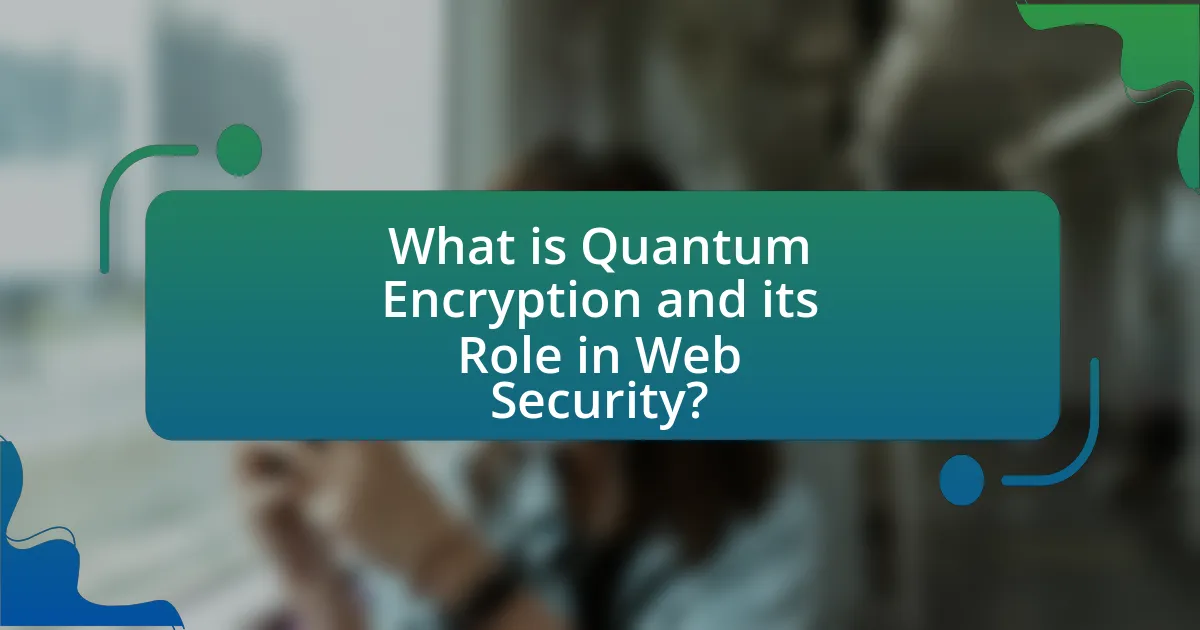Quantum encryption is a cutting-edge technology that utilizes the principles of quantum mechanics to secure data, primarily through quantum key distribution (QKD). This article explores the significance of quantum encryption in enhancing web security, particularly in the face of emerging threats from quantum computing. Key topics include the differences between quantum and traditional encryption methods, the fundamental principles of quantum encryption, its applications across various industries, and the challenges associated with its implementation. Additionally, the article addresses the evolving landscape of web security, the role of governments and regulations, and the practical applications of quantum encryption in sectors such as finance and healthcare.

What is Quantum Encryption and its Role in Web Security?
Quantum encryption is a method of securing data using the principles of quantum mechanics, primarily through quantum key distribution (QKD). QKD allows two parties to generate a shared, secret random key, which is provably secure against eavesdropping due to the laws of quantum physics. This technology plays a crucial role in web security by providing a means to protect sensitive information from potential threats posed by quantum computers, which could break traditional encryption methods. For instance, the implementation of QKD has been demonstrated in various real-world applications, such as the secure communication network established by the Chinese satellite Micius, which successfully transmitted quantum keys over long distances, showcasing the practical viability of quantum encryption in enhancing web security.
How does Quantum Encryption differ from traditional encryption methods?
Quantum encryption fundamentally differs from traditional encryption methods by utilizing the principles of quantum mechanics to secure data. Traditional encryption relies on mathematical algorithms and keys, which can potentially be broken by powerful computers or through brute-force attacks. In contrast, quantum encryption, specifically Quantum Key Distribution (QKD), employs quantum bits (qubits) that are governed by the laws of quantum physics, ensuring that any attempt to intercept or measure the qubits alters their state, thereby alerting the communicating parties to the presence of an eavesdropper. This inherent property of quantum mechanics provides a level of security that is theoretically unbreakable, as demonstrated by the BB84 protocol developed by Charles Bennett and Gilles Brassard in 1984, which is a foundational example of QKD.
What are the fundamental principles of Quantum Encryption?
Quantum encryption fundamentally relies on the principles of quantum mechanics, specifically superposition and entanglement. Superposition allows quantum bits (qubits) to exist in multiple states simultaneously, enabling the transmission of information in a way that is fundamentally different from classical bits. Entanglement creates a correlation between qubits such that the state of one qubit instantly influences the state of another, regardless of distance. These principles ensure that any attempt to eavesdrop on the quantum communication alters the state of the qubits, thereby alerting the communicating parties to the presence of an intruder. This inherent security feature is what distinguishes quantum encryption from traditional encryption methods, making it a promising solution for secure web communications.
How does Quantum Key Distribution (QKD) enhance security?
Quantum Key Distribution (QKD) enhances security by enabling the generation and distribution of cryptographic keys through quantum mechanics, ensuring that any eavesdropping attempts can be detected. QKD utilizes principles such as quantum superposition and entanglement, which allow two parties to share a key securely; if an unauthorized party tries to intercept the key, the quantum state will change, alerting the legitimate users. This capability is supported by the no-cloning theorem, which states that quantum information cannot be copied, further reinforcing the security of the key exchange process.
Why is Quantum Encryption important for the future of web security?
Quantum encryption is crucial for the future of web security because it offers a level of protection against cyber threats that classical encryption methods cannot match. This technology leverages the principles of quantum mechanics, specifically quantum key distribution (QKD), to create secure communication channels that are theoretically immune to eavesdropping. For instance, any attempt to intercept quantum keys would disturb the quantum states, alerting the communicating parties to potential breaches. As cyber attacks become increasingly sophisticated, with quantum computers posing a significant threat to traditional encryption algorithms, the adoption of quantum encryption will be essential to safeguard sensitive data and maintain the integrity of online transactions.
What vulnerabilities in current encryption methods does Quantum Encryption address?
Quantum Encryption addresses vulnerabilities in current encryption methods, particularly those related to the potential for quantum computers to break traditional cryptographic algorithms. Current encryption methods, such as RSA and ECC, rely on the difficulty of mathematical problems like integer factorization and discrete logarithms, which quantum algorithms, specifically Shor’s algorithm, can solve efficiently. This capability poses a significant threat to data security, as it could allow unauthorized access to encrypted information. Quantum Encryption, utilizing principles of quantum mechanics, ensures that any attempt to intercept or measure the quantum keys used for encryption alters the keys themselves, thereby alerting the parties involved and maintaining the integrity of the communication.
How can Quantum Encryption protect against quantum computing threats?
Quantum encryption can protect against quantum computing threats by utilizing the principles of quantum mechanics to secure data transmission. This method, specifically quantum key distribution (QKD), ensures that any attempt to intercept or eavesdrop on the communication alters the quantum state of the transmitted data, thereby alerting the parties involved to the presence of an intruder. For instance, the BB84 protocol, developed by Charles Bennett and Gilles Brassard in 1984, demonstrates how quantum bits (qubits) can be used to create a secure key that is theoretically immune to the computational power of quantum computers. This resilience is due to the fundamental properties of quantum mechanics, such as superposition and entanglement, which provide a level of security unattainable by classical encryption methods.
What are the potential challenges of implementing Quantum Encryption?
The potential challenges of implementing Quantum Encryption include technological limitations, high costs, and the need for new infrastructure. Technological limitations arise from the current state of quantum technology, which is still in development and may not yet be reliable for widespread use. High costs are associated with the advanced equipment and expertise required to deploy quantum encryption systems, making it less accessible for many organizations. Additionally, existing infrastructure may need significant upgrades to support quantum communication, creating further barriers to implementation. These challenges highlight the complexities involved in transitioning to quantum encryption for web security.
What technological barriers exist for widespread adoption?
Technological barriers for widespread adoption of quantum encryption in web security include high costs, limited infrastructure, and the complexity of implementation. High costs arise from the need for specialized hardware and expertise, which can deter organizations from investing in quantum technologies. Limited infrastructure is evident as current internet frameworks are not designed to support quantum communication, necessitating significant upgrades. Additionally, the complexity of implementing quantum encryption protocols requires advanced knowledge and training, which many organizations lack. These factors collectively hinder the transition to quantum encryption, as evidenced by studies indicating that only a small percentage of companies are currently prepared to adopt such technologies.
How do costs and infrastructure impact the deployment of Quantum Encryption?
Costs and infrastructure significantly impact the deployment of Quantum Encryption by determining the feasibility and scalability of its implementation. High costs associated with quantum hardware, such as specialized photon sources and detectors, can limit accessibility for organizations, particularly small and medium enterprises. Additionally, the existing infrastructure must be upgraded to support quantum communication technologies, which often requires substantial investment in fiber optics and quantum repeaters. For instance, a report by the European Commission highlights that the estimated cost for developing a robust quantum communication network could reach billions of euros, emphasizing the financial barrier to widespread adoption. Thus, both the economic and infrastructural requirements play crucial roles in shaping the future landscape of Quantum Encryption in web security.
How is the landscape of web security evolving with Quantum Encryption?
The landscape of web security is evolving significantly with the introduction of Quantum Encryption, which offers unprecedented levels of security against cyber threats. Quantum Encryption utilizes principles of quantum mechanics, such as superposition and entanglement, to create encryption keys that are theoretically unbreakable by classical computers. This advancement is crucial as it addresses vulnerabilities posed by the potential future capabilities of quantum computers, which could easily decrypt traditional encryption methods. For instance, the National Institute of Standards and Technology (NIST) has been actively working on post-quantum cryptography standards to prepare for this shift, highlighting the urgency and importance of integrating Quantum Encryption into web security frameworks.
What industries are likely to benefit most from Quantum Encryption advancements?
The industries likely to benefit most from Quantum Encryption advancements include finance, healthcare, and telecommunications. The finance industry requires robust security measures to protect sensitive data and transactions, making quantum encryption essential for safeguarding against cyber threats. In healthcare, patient data privacy is paramount, and quantum encryption can enhance the security of electronic health records against unauthorized access. Telecommunications will also benefit as quantum encryption can secure communication channels, ensuring that data transmitted over networks remains confidential and tamper-proof. These industries are particularly vulnerable to cyberattacks, and the implementation of quantum encryption can significantly mitigate risks associated with data breaches.

What are the current trends in Quantum Encryption technology?
Current trends in Quantum Encryption technology include the development of Quantum Key Distribution (QKD) systems, advancements in post-quantum cryptography, and the integration of quantum technologies with existing cybersecurity frameworks. QKD systems, such as those being implemented by companies like ID Quantique and Toshiba, utilize quantum mechanics to securely distribute encryption keys, ensuring that any eavesdropping attempts can be detected. Additionally, research in post-quantum cryptography aims to create algorithms that remain secure against potential quantum attacks, with organizations like NIST actively working on standardizing these algorithms. Furthermore, the convergence of quantum technologies with classical encryption methods is being explored to enhance overall security in web applications, as evidenced by collaborations between tech firms and academic institutions.
How are researchers and companies innovating in Quantum Encryption?
Researchers and companies are innovating in Quantum Encryption by developing advanced quantum key distribution (QKD) systems that leverage the principles of quantum mechanics to secure data transmission. For instance, companies like ID Quantique and Toshiba have created QKD solutions that utilize entangled photons to ensure that any interception of the key can be detected, thereby enhancing security. Additionally, researchers are exploring new protocols such as measurement-device-independent QKD, which eliminates vulnerabilities associated with the measurement devices used in traditional QKD systems. These innovations are supported by studies demonstrating that quantum encryption can provide theoretically unbreakable security, as outlined in the work of Bennett and Brassard in their seminal 1984 paper on QKD.
What recent breakthroughs have been made in Quantum Encryption technology?
Recent breakthroughs in Quantum Encryption technology include the development of quantum key distribution (QKD) systems that utilize satellite communication, enabling secure data transmission over long distances. For instance, in 2022, China successfully demonstrated a QKD system using its Micius satellite, achieving secure communication over 4,600 kilometers. This advancement enhances the practicality of quantum encryption for global communications, addressing previous limitations related to distance and scalability. Additionally, researchers have made strides in integrating quantum encryption with existing internet infrastructure, facilitating its adoption in real-world applications.
How are partnerships and collaborations shaping the future of Quantum Encryption?
Partnerships and collaborations are significantly advancing the future of Quantum Encryption by pooling expertise and resources from various sectors, including academia, industry, and government. For instance, initiatives like the Quantum Internet Alliance, which includes multiple universities and tech companies, aim to develop quantum communication technologies that enhance security protocols. These collaborations facilitate knowledge sharing and accelerate the development of practical quantum encryption solutions, evidenced by projects such as the European Quantum Communication Infrastructure, which seeks to establish a secure quantum communication network across Europe. Such partnerships not only drive innovation but also help in standardizing quantum encryption methods, ensuring interoperability and broader adoption in web security.
What role do governments and regulations play in Quantum Encryption development?
Governments and regulations play a crucial role in the development of quantum encryption by establishing frameworks that guide research, funding, and implementation. These entities often allocate resources to quantum technology initiatives, as seen in the U.S. National Quantum Initiative Act of 2018, which aims to accelerate quantum research and development. Additionally, regulations ensure that quantum encryption technologies meet security standards, fostering trust and adoption in various sectors, including finance and telecommunications. For instance, the European Union’s Quantum Communication Infrastructure initiative emphasizes the need for secure communication channels, directly influencing the direction of quantum encryption advancements.
How are international standards for Quantum Encryption being established?
International standards for Quantum Encryption are being established through collaborative efforts among organizations such as the International Organization for Standardization (ISO) and the Institute of Electrical and Electronics Engineers (IEEE). These organizations are working to create frameworks that define protocols, security measures, and best practices for implementing quantum encryption technologies.
For instance, the ISO/IEC JTC 1/SC 27 committee focuses on information security, including quantum cryptography, to ensure that standards are aligned with technological advancements. Additionally, the National Institute of Standards and Technology (NIST) is actively involved in developing post-quantum cryptography standards, which will influence global practices in quantum encryption. These initiatives are crucial for ensuring interoperability and security in a future where quantum computing capabilities could threaten traditional encryption methods.
What policies are being implemented to encourage Quantum Encryption research?
Governments and organizations are implementing various policies to encourage Quantum Encryption research, including funding initiatives, collaborative research programs, and regulatory frameworks. For instance, the U.S. National Quantum Initiative Act allocates significant federal funding to quantum research, promoting advancements in quantum technologies, including encryption. Additionally, the European Union’s Quantum Flagship program invests €1 billion over ten years to support quantum research and innovation, fostering collaboration among academic institutions and industry. These policies aim to enhance national security and maintain technological leadership in the rapidly evolving field of quantum computing and encryption.

What practical applications of Quantum Encryption exist today?
Practical applications of Quantum Encryption today include secure communication systems, quantum key distribution (QKD), and enhanced cybersecurity measures. Secure communication systems utilize quantum encryption to ensure that data transmitted over networks remains confidential and tamper-proof. Quantum key distribution, exemplified by technologies like the BB84 protocol, allows two parties to generate a shared, secret key with security guaranteed by the laws of quantum mechanics. Enhanced cybersecurity measures are being implemented in financial institutions and government agencies, where quantum encryption protects sensitive information from potential threats posed by quantum computing. These applications demonstrate the growing integration of quantum encryption in securing digital communications and data integrity.
How is Quantum Encryption being utilized in various sectors?
Quantum encryption is being utilized in various sectors primarily for enhancing data security through quantum key distribution (QKD). In the financial sector, institutions like banks are implementing QKD to secure transactions and protect sensitive customer information from cyber threats. The healthcare industry employs quantum encryption to safeguard patient data and ensure compliance with regulations such as HIPAA, thereby preventing unauthorized access to medical records. Additionally, government agencies are adopting quantum encryption to secure communications and protect national security interests against potential cyber espionage. These applications demonstrate the growing importance of quantum encryption in providing robust security solutions across multiple sectors.
What examples of Quantum Encryption in finance and banking can be observed?
Quantum encryption is being implemented in finance and banking through various initiatives, such as the use of Quantum Key Distribution (QKD) by institutions like the Bank of America and the European Central Bank. These organizations are exploring QKD to secure communications and transactions against potential threats posed by quantum computing. For instance, the European Quantum Communication Infrastructure (EuroQCI) project aims to establish a secure quantum communication network across Europe, enhancing the security of financial transactions. Additionally, companies like ID Quantique provide quantum-safe encryption solutions that are being adopted by banks to protect sensitive data. These examples demonstrate the growing integration of quantum encryption technologies in the financial sector to safeguard against future cyber threats.
How is Quantum Encryption being applied in healthcare data security?
Quantum encryption is being applied in healthcare data security primarily through the implementation of quantum key distribution (QKD) systems. These systems enable secure communication by using the principles of quantum mechanics to generate and share encryption keys that are theoretically immune to eavesdropping. For instance, hospitals and healthcare organizations are utilizing QKD to protect sensitive patient information during transmission, ensuring that data remains confidential and secure from cyber threats. Research has shown that QKD can detect any interception attempts, providing an additional layer of security that traditional encryption methods cannot offer. This application is crucial as healthcare data breaches can lead to severe consequences, including identity theft and compromised patient care.
What best practices should organizations follow when adopting Quantum Encryption?
Organizations should follow a structured approach when adopting Quantum Encryption, focusing on thorough risk assessment, integration with existing security frameworks, and continuous training for personnel. Conducting a comprehensive risk assessment allows organizations to identify specific vulnerabilities that Quantum Encryption can address, ensuring that the technology is applied where it is most needed. Integrating Quantum Encryption with existing security frameworks ensures compatibility and maximizes the effectiveness of current security measures, as evidenced by studies showing that hybrid systems can enhance overall security posture. Continuous training for personnel is crucial, as the technology is complex and requires a deep understanding to implement effectively; organizations that invest in training report higher success rates in deployment and operation.
How can organizations prepare their infrastructure for Quantum Encryption integration?
Organizations can prepare their infrastructure for Quantum Encryption integration by upgrading their existing cryptographic systems to support quantum-resistant algorithms. This involves assessing current encryption methods, identifying vulnerabilities to quantum attacks, and implementing post-quantum cryptography standards, such as those recommended by the National Institute of Standards and Technology (NIST). Additionally, organizations should invest in training their IT staff on quantum technologies and establish partnerships with quantum technology providers to facilitate a smooth transition. This proactive approach is essential, as studies indicate that quantum computers could break widely used encryption methods within the next decade, making early preparation critical for maintaining data security.
What training and resources are necessary for effective implementation of Quantum Encryption?
Effective implementation of Quantum Encryption requires specialized training in quantum mechanics, cryptography, and information technology. Professionals must understand quantum key distribution (QKD) protocols, such as BB84 and E91, which are foundational to secure quantum communication. Resources necessary for this implementation include access to quantum computing hardware, simulation software for testing quantum algorithms, and educational materials that cover both theoretical and practical aspects of quantum encryption. Research institutions and universities often provide workshops and courses that focus on these areas, ensuring that practitioners are equipped with the latest knowledge and skills in quantum technologies.




